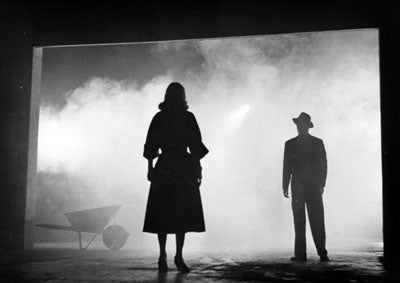Download a sample list of available titles and additional research resources at UCLA in PDF format.
Literally meaning "black," the concept of "noir" was first applied in France to describe the British Gothic novel. It was later used in "Serie Noire," a collection of American fiction, translated into French, including the writings of "hard-boiled" novelists such as Raymond Chandler, Dashiell Hammett, Cornell Woolrich, James M. Cain and Horace McCoy. French film critics coined the term "film noir" by analogy with those literary works (many of which had been made into film).
Many noir films were crafted by German and central European émigrés, trained in the UFA studios in the 1920s and early 1930s and influenced by German Expressionism. The noir ambience is dominated by low-key lighting, chiaroscuro effects and deep shadows, creating feelings of disorientation, loneliness and entrapment.
Along with other critics, Paul Schrader feels that the cycle of noir films starts with John Huston's The Maltese Falcon (1941), and begins to decline after Orson Welles' Touch of Evil (1958). Within these years, noir directors included Fritz Lang, Billy Wilder, Robert Siodmak, Michael Curtiz, William Dieterle and Otto Preminger. Titles such as The Big Sleep (1945-6), Call Northside 777 (1948), Murder, My Sweet (Farewell My Lovely) (1944) and Kiss Me Deadly (1955) are examples of noir style and storyline.
The noir style periodically resurfaces as an homage to these Hollywood classics. Though shot in color, American films like Bullitt (1968), Klute (1971), Chinatown (1974), Body Heat (1981) and the recent remakes of The Postman Always Rings Twice and D.O.A. are a tribute to the noir sensibility. The stylistic aesthetics and narrative techniques of noir were also prevalent on American television.
Thanks to the generous support of Film Noir Foundation, UCLA Film & Television Archive has restored many classic and rediscovered noir films:
Cry Danger (1951)
The Guilty (1947)
High Tide (1947)
The Man Who Cheated Himself (1950)
The Prowler (1951)
Repeat Performance (1947)
Los tallos amargos (The Bitter Stems, 1956)
Too Late for Tears (1949)
Try and Get Me (The Sound of Fury, 1951)
Woman on the Run (1950)
To arrange onsite research viewing access, please contact the Archive Research and Study Center (ARSC).







